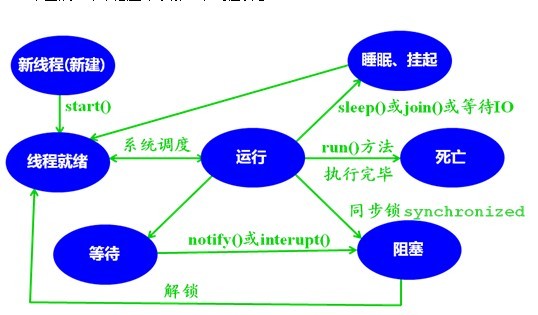Java多线程
来源:互联网 发布:微信矩阵营销 编辑:程序博客网 时间:2024/06/06 15:02
一、线程的五种状态
使用Java能方便的写出多线程代码,如果在使用前能了解线程运行时的各种状态,对于理解线程编程会有很大助益
下面从一个示意图来了解一下线程状态:

当一个线程被创建后,调用它的start()方法,使其进入可运行状态,也就说调用完start方法后线程并不会立即运行,而是处于就绪状态。一旦进入运行状态,就会有三种结果:
1、线程执行完毕(死亡)
2、线程由于各种原因,比如说睡眠、运行超时、更高优先级的线程进入、IO等待或join等等,这个时候则暂停运行。
3、在线程运行过程中,调用了某一对象的wait方法,直到其它线程调用此对象的notify或notifyAll 方法,使当前线程恢复可运行状态。可 运行状态指的是java的线程调度器已经通知了操作系统,将这个线程安排到就绪队列,等待CPU执行。
二、线程的概念
通俗的理解:线程不是一行代码,也不是一个方法,它是一个执行序列。所有代码都在这个序列当中一步步执行至到结束。
三、在java中创建线程有两种方法
1、继承Thread 重写run方法
2、实现Runnable接口 实现其中的run 方法
前面三点了解一下先,接下来看迅雷公司的这道笔试题:
有三个线程ID分别是A、B、C,请有多线编程实现,在屏幕上循环打印10次ABCABC…
第一种方法如下:
- package org;
- public class ThreadABC {
- public static void main(String[] args) {
- Thread_E tc = new Thread_E();
- Thread_E tb = new Thread_E();
- Thread_E td = new Thread_E();
- Thread_A ta = new Thread_A();
- ta.setThread(tb);
- tb.setThread(tc);
- tc.setThread(td);
- td.setThread(ta);
- ta.setName("A");
- tb.setName("B");
- tc.setName("C");
- td.setName("D");
- ta.start();
- tb.start();
- tc.start();
- td.start();
- }
- }
- class Thread_A extends Thread {
- Thread t;
- public void setThread(Thread t) {
- this.t = t;
- }
- public void run() {
- int i = 0;
- while(i++ < 10) {
- System.out.print(Thread.currentThread().getName());
- t.interrupt();
- try {
- this.join();
- } catch (InterruptedException e) {
- }
- }
- }
- }
- class Thread_E extends Thread {
- Thread t;
- public void setThread(Thread t) {
- this.t = t;
- }
- public void run() {
- int i = 0;
- while(i++ < 10) {
- try {
- this.join();
- } catch (InterruptedException e) {
- }
- System.out.print(Thread.currentThread().getName());
- t.interrupt();
- }
- }
- }
第二种方法如下:
- package com;
- public class PrintABC {
- public static void main(String[] args) {
- MajusculeABC maj = MajusculeABC.newInstance();
- Thread t_a = new Thread(new Thread_ABC(maj , 'A'));
- Thread t_b = new Thread(new Thread_ABC(maj , 'B'));
- Thread t_c = new Thread(new Thread_ABC(maj , 'C'));
- t_a.start();
- t_b.start();
- t_c.start();
- }
- }
- class MajusculeABC {
- private char charactor = 'A';
- /* 限制此类只创建一个对象 */
- private static MajusculeABC maObj =null;
- private MajusculeABC() {}
- public static MajusculeABC newInstance(){
- if(maObj == null) {
- maObj = new MajusculeABC();
- }
- return maObj;
- }
- public void setCharactor() {
- this.charactor += 1;
- if(this.charactor == 'D') {
- this.charactor = 'A';
- }
- }
- public char getCharactor() {
- return this.charactor;
- }
- }
- class Thread_ABC implements Runnable {
- private MajusculeABC maj;
- private char charactor = ' ';
- public Thread_ABC(MajusculeABC maj, char charactor) {
- this.maj = maj;
- this.charactor = charactor;
- }
- public void run() {
- int i = 0;
- while (i<10) {
- synchronized (maj) {
- while(this.charactor != maj.getCharactor()) {
- try {
- maj.wait();
- } catch (InterruptedException e) {}
- }
- System.out.print(this.charactor);
- i++;
- maj.setCharactor();
- maj.notifyAll();
- }
- }
- }
- }
以上两种方法都未写注释,第一种方法使用线程中的join() 达到目的,第二种方法就是同步对象
对于线程的各种状态、线程间的通信、线程组、线程池等等,下回分解
本文转自http://blog.csdn.net/brilliancezhou/article/details/5504727
- 【Java多线程】多线程死锁
- Java 多线程
- java 多线程
- java多线程
- JAVA多线程
- java多线程
- JAVA多线程
- java多线程
- JAVA 多线程
- Java多线程
- java多线程
- JAVA 多线程
- Java 多线程
- Java 多线程
- java多线程
- Java 多线程
- Java多线程
- java 多线程
- GTK、Qt和wxWidgets
- Xcode调试攻略
- jsp中的一个下拉列表实例
- ajax提交数据(修改、新增)到数据库并刷新数据
- 打印linux内核信息
- Java多线程
- Linux 的 复制命令 【 cp 】 (copy)及其 (常用参数 -fp)
- 黑马程序员----Java(IO流)
- 用Visio画E-R图
- JAVA访问权限控制
- AS3内存泄露
- UVa OJ 10044 - Erdos Numbers
- Linux上的free命令详解
- STM32开源项目


